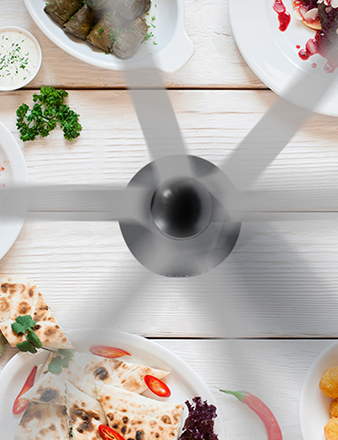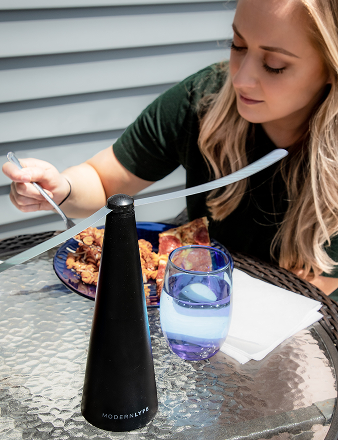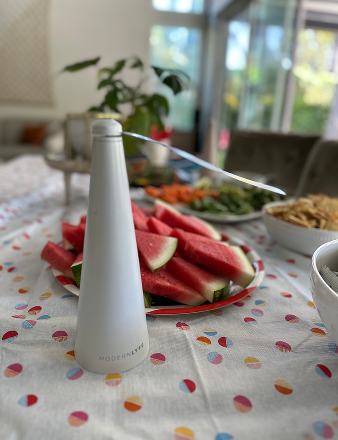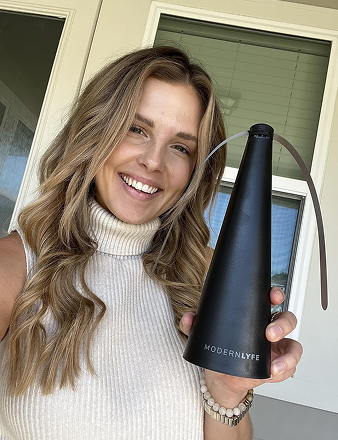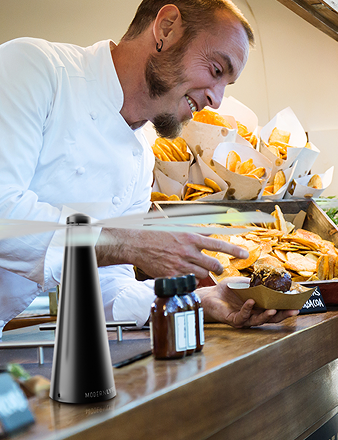You've set the perfect outdoor table, but within minutes, buzzing flies arrive. It’s an instant mood-killer. Fly fans for tables are the simple, chemical-free solution. They use quiet, spinning blades with reflective patterns to create an invisible barrier that keeps pests away from your food. They're safe, effective, and let you enjoy your meal in peace.
The Modern Fix for Pest-Free Dining
Nothing ruins an outdoor meal faster than flies. For years, the options were bad: smelly citronella candles, gross sticky traps, or chemical sprays you'd never want near your food. It felt like a losing battle between enjoying the fresh air and protecting your plate.
Fly fans for tables change the game. They are a modern, effective way to create a pest-free zone without the downsides of old methods. Instead of attracting or killing flies, these devices simply convince them to go somewhere else.
How They Create a "No-Fly Zone"
The technology is simple but smart. First, the soft, reflective blades spin and create a visual disruption. A fly has compound eyes, so the constantly moving, fractured light looks like a threat. It’s disorienting, and they instinctively steer clear.
At the same time, the spinning blades generate a gentle air current. You'll barely feel it, but to a tiny fly, it’s like a windstorm. This breeze makes it difficult for them to fly steadily or land anywhere within the fan's radius.
By combining visual confusion with gentle air disruption, a single fan effectively guards a standard dining table, creating an invisible shield that pests won't cross.
More Than Just a Fly Repellent
Fly fans are designed with the entire dining experience in mind, offering key benefits that make them essential for restaurants, events, and backyard patios.
Here’s what makes them stand out:
- Totally Safe: The blades are made from a soft, flexible material with soft-stop technology. If a hand touches them, they stop instantly, making them completely safe for families and pets.
- Whisper-Quiet: Forget the loud ZAP! of a bug zapper. These devices are virtually silent. They protect your space without adding noise, so conversations can continue uninterrupted.
- No Chemicals, No Odors: There are no pesticides, chemicals, or scents involved. You can place them right next to food without worrying about contamination or unwanted smells.
- Sleek and Unobtrusive: Modern fly fans are designed to be slim and stylish, blending in with your table setting instead of looking like clunky pest control equipment.
These devices aren't just gadgets; they're an investment in a better atmosphere. For anyone who hosts, they offer the peace of mind that comes from knowing guests can relax in a clean, comfortable, and pest-free setting.
How Fly Fans Outsmart Flies
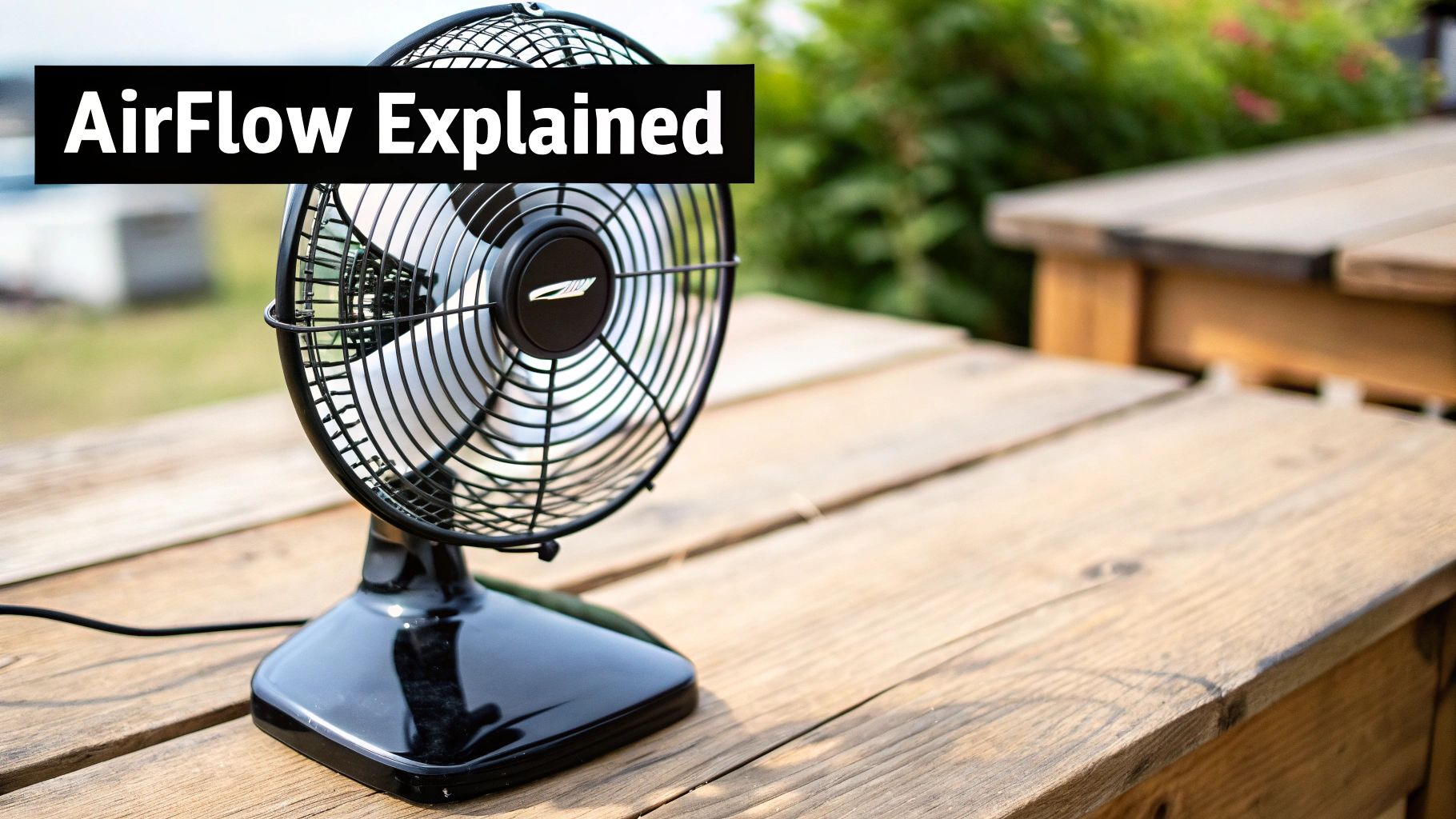
Ever wondered how such a simple device is so good at keeping pests away? The secret behind fly fans for tables isn't high-tech wizardry. It’s a clever trick that uses a fly's own biology against it.
Instead of chemicals or zappers, these fans create an environment that flies instinctively avoid. It comes down to a one-two punch that disrupts their senses of sight and touch, creating a powerful "no-fly zone" right over your food.
The Power of Visual Disruption
The most important piece of the puzzle is what the fly sees.
The fan blades feature holographic patterns that catch and scatter light as they spin. A fly's compound eyes are made of thousands of lenses, making them hyper-sensitive to movement and flickering light.
To a fly, the spinning, reflective blades are a massive, unpredictable visual threat. Its brain can't process the fractured light, making the area seem dangerous. This triggers its self-preservation instinct, forcing it to veer away.
The constant, shifting reflections from the fan blades act as a visual stop sign. A fly’s compound eyes read the chaotic light as a direct threat, forcing it to change course long before it gets near your plate.
An Invisible Wall of Air
While the visual trickery is powerful, fly fans have a second layer of defense: a gentle air current. As the blades spin, they create a subtle breeze. For us, this airflow is barely noticeable and won't send napkins flying.
For a small insect like a fly, however, that breeze feels like a windstorm. Flies need calm air to navigate and land. The air movement from the fan creates an invisible barrier that disrupts their flight path.
- Tricky Landings: The gentle currents make it nearly impossible for a fly to land on the table or your food.
- Too Much Work: Flying through this "wind" takes more energy, making your table an unappealing place to be.
- Sensory Annoyance: The constant air pressure on their wings is an annoying sensation that encourages them to find a calmer spot.
This combination of visual confusion and air disruption is what makes fly fans for tables so effective. They don't just repel flies; they outsmart them.
You can find out more about how the MODERN LYFE fly fan for tables serves as your ultimate dining ally in our guide. This science-backed approach keeps your meals peaceful and fly-free without noise, smells, or chemicals.
How to Choose the Right Fly Fan
With many fly fans on the market, picking the right one comes down to a few key features. Knowing what to look for will help you find the perfect model for your needs.
The best choice depends on its power source, physical design, and extra features. Considering these points will help you find a fan that not only works well but also fits your dining setup.
Power Source: Battery vs. Rechargeable
Your first decision is how to power it: disposable batteries or a built-in rechargeable one. Each has its pros and cons.
-
Disposable Battery Models: These fans typically run on standard AA batteries, making them convenient for picnics, camping, or anywhere without an outlet. The downside is that the cost of new batteries can add up with frequent use.
-
USB-Rechargeable Models: For regular use, a rechargeable model is a smart investment. It’s more eco-friendly and cost-effective in the long run. A single charge provides hours of protection, and you can easily power it up with a power bank or wall adapter. This is the go-to choice for restaurant patios and home use.
Think of it like choosing a gas or electric car. One is quick to "refuel," while the other saves money over time.
Design and Physical Features
A fan's design is just as important as its power source, affecting safety and table space.
The most critical feature is soft-stop safety blades. This is a must-have, especially around children or pets. The soft, flexible blades are designed to stop spinning on contact, eliminating any risk of injury.
Next, consider the fan’s height and stability. Taller fans often provide better coverage for large tables. Shorter, compact designs are great for small bistro tables. Ensure the base is wide and stable enough to prevent tipping.
A game-changing feature to look for is a hanging hook, often built into the base. This lets you hang the fan upside down from an umbrella or tent, saving precious table space at buffets.
The image below compares different models on key metrics like airflow and noise.
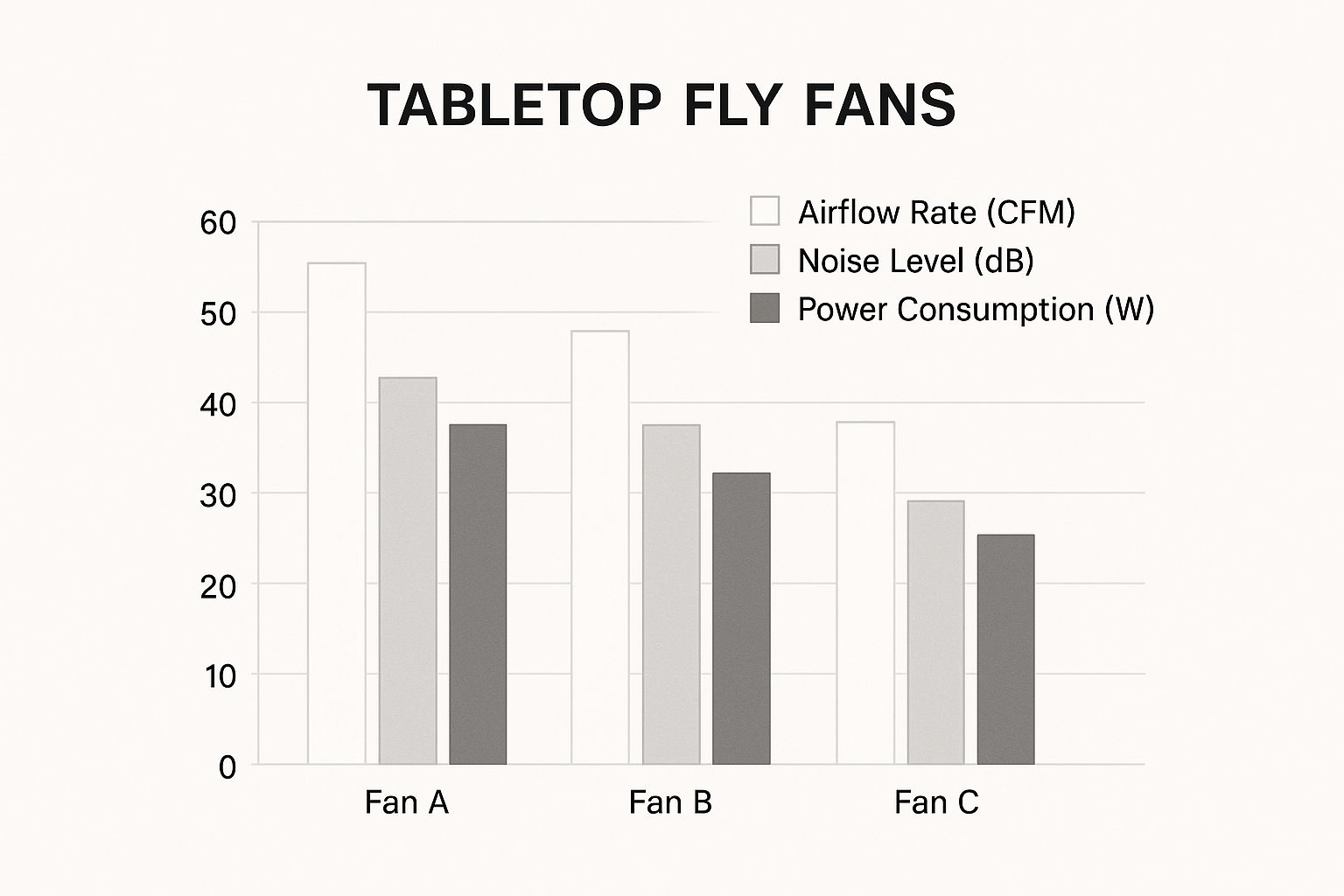
As you can see, there's often a trade-off. More powerful airflow might be louder or use more battery, so it's about finding the right balance for your situation.
Fly Fan Feature Comparison Guide
Use this table to quickly compare fly fan models and find the features that matter most for your dining setup.
| Feature | Battery-Operated Models | USB-Rechargeable Models | Hanging Models |
|---|---|---|---|
| Best For | Picnics, camping, occasional use, and areas without power. | Frequent use, restaurant patios, and home decks. | Buffet tables, umbrellas, and outdoor tents. |
| Portability | Excellent. Grab-and-go convenience. | Very Good. Requires charging but portable once powered. | Excellent. Frees up table space entirely. |
| Running Cost | Higher over time due to battery replacement. | Lower. Cheaper to recharge than to buy new batteries. | Varies by power source (can be battery or rechargeable). |
| Key Feature | Simplicity and readiness for immediate use. | Cost-effective and environmentally friendly for regular use. | Overhead protection without cluttering the dining surface. |
| Common Extras | Often basic, focused on core function. | May include LED lights and multiple speed settings. | Designed with a built-in hook for easy suspension. |
This comparison should help you choose the model that best fits your lifestyle, whether you need maximum portability or a set-and-forget solution for your patio.
Extra Features That Add Value
Finally, look for bonus features that can improve your experience.
An integrated LED light is perfect for dinners that last into the evening, providing ambient light while the fan works. It’s two useful gadgets in one.
Another great extra is multiple speed settings. While a single speed often works, the ability to increase airflow is a plus on breezy days or when pests are particularly persistent. It gives you more control.
By weighing power, design, and extra features, you can confidently choose a fly fan that’s perfect for you.
How to Create a Flawless, Fly-Free Zone
You have your fly fan. Turning it on is a good start, but a little strategy can make your setup impenetrable. The key to a truly bug-free meal is placement, quantity, and a few smart adjustments.
Think of each fan’s effective area as an invisible shield. The center is strong, but the edges are weaker. The goal is to arrange your fans so their shields overlap, creating a seamless barrier with no gaps for flies to exploit.
Strategic Placement
Where you put your fly fans for tables matters. The right spot maximizes both the disruptive airflow and the visual distraction that keeps flies away.
Flies are drawn to food, especially grilled meats, desserts, and fruit. By placing a fan right next to these high-value targets, you create a powerful first line of defense.
For the best results, follow these guidelines:
- Go Central: For a small, round table, one fan in the middle provides excellent all-around coverage.
- Guard the Food: Position fans closest to the dishes that attract flies most, like sugary drinks or protein.
- Keep it Steady: Make sure the fan is on a flat, stable surface where it won't get knocked over.
How Many Fly Fans Do You Need?
The number of fans depends on your table size. Trying to cover a large area with a single fan will leave weak spots.
One fan generally covers 4 to 5 square feet—perfect for a two-person café table. For larger tables, you need to create overlapping zones of protection.
Think of it like setting up sprinklers. You wouldn't use just one for a large lawn; you'd arrange several so their spray patterns overlap. It's the same idea with fly fans.
Here’s a quick guide:
- Small Bistro Table (2-4 people): One fan in the center is usually sufficient.
- Standard Dining Table (6-8 people): Use two fans. Place one at each end to create a protected zone down the length of the table.
- Long Banquet or Buffet Table: Use one fan every 3-4 feet. For an 8-foot banquet table, three fans will create a powerful, uninterrupted barrier.
Tactics for Different Scenarios
Your strategy may need to change with the setting. A windy patio or a crowded buffet presents different challenges. Adapting your approach ensures your fly fans perform at their best.
Buffet tables are a prime example. This is where hanging fly fans are ideal. Suspend them from a tent frame or umbrella to protect the food without cluttering the table.
Here are a few pro tips:
- Breezy Conditions: On a windy day, place fans on the upwind side of the table. This uses the natural breeze to create a super-charged barrier that pushes pests away.
- Crowded Events: At a busy party, tuck fans into low-traffic spots on the table so they don't get accidentally bumped.
- Evening Ambiance: For dining after dark, use fans with built-in LED lights. They add to the atmosphere and can help deter moths and other nocturnal insects.
By mastering placement and using the right number of fans, your fly fans for tables will become your most reliable tool for a pest-free gathering.
Fly Fans in Action
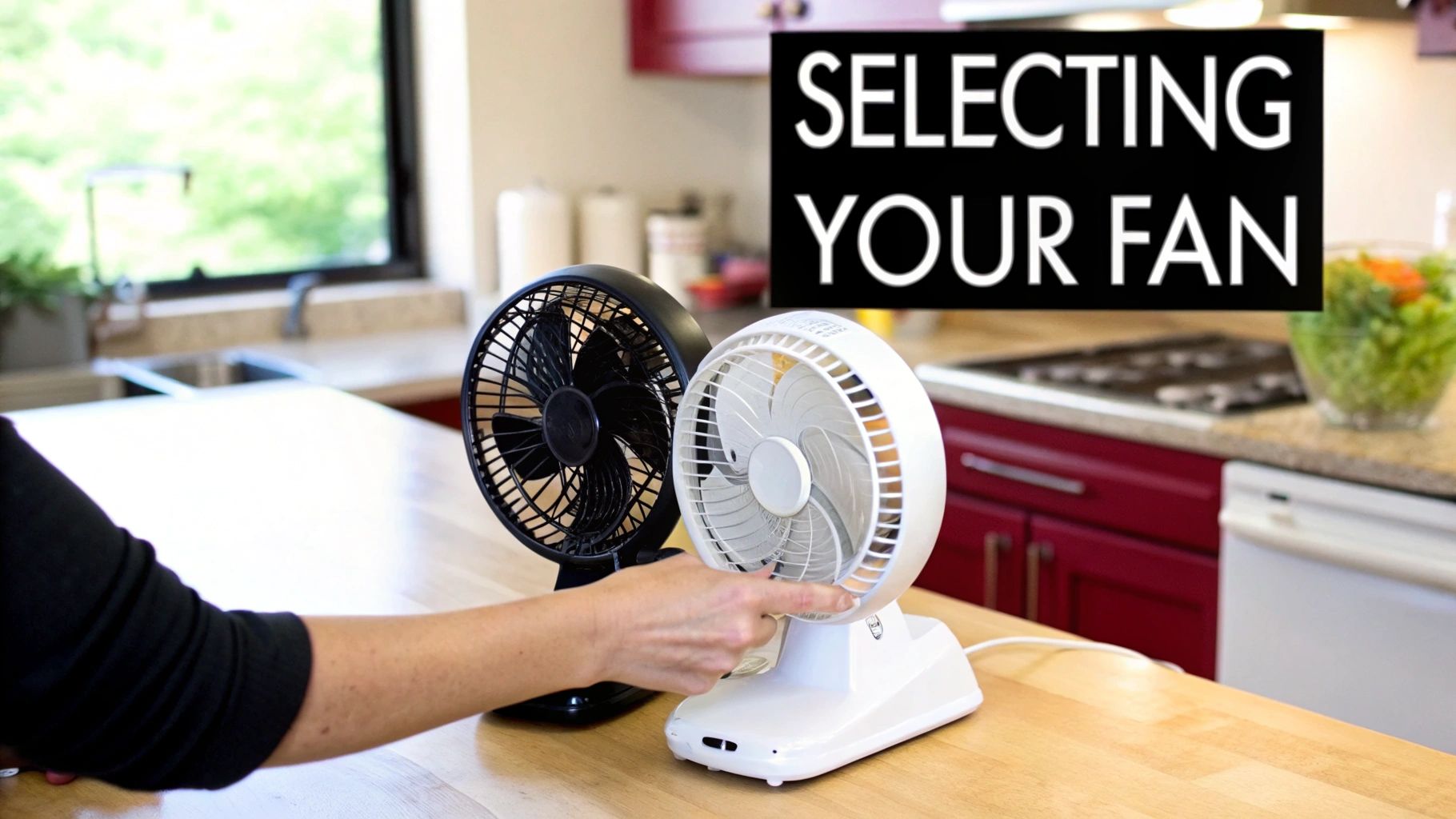
Understanding how a fly fan works is one thing; seeing it solve real-world problems is another. These are practical tools that improve experiences at cafes, barbecues, and even outdoor weddings.
The real value of fly fans for tables is their adaptability. They solve the universal problem of flies in a way that’s safe, quiet, and unobtrusive. Here are a few common scenarios where these fans make all the difference.
The Bustling Cafe Patio
Picture a popular sidewalk cafe. The aroma of coffee and pastries is in the air, but so are the flies. Chemical sprays are out, and a loud zapper would ruin the vibe.
This is where fly fans for tables shine. A fan on each table silently protects guests, who can enjoy their food without swatting at pests. For the cafe owner, it's a small investment that leads to happier customers and better reviews.
The Elegant Outdoor Wedding
At an outdoor wedding reception, every detail matters. The last thing you want is for a beautiful buffet to attract flies. Aesthetics and function must work together.
Fly fans provide a discreet solution. Place several fans along the buffet line to create an invisible shield that doesn't clash with the decor. They are silent and odorless, so they won’t interfere with toasts or music. Hanging models can be suspended from tent rigging for overhead protection, freeing up table space.
By keeping the food pristine, fly fans help maintain the event's sophisticated atmosphere. Guests can focus on the celebration, not the pests.
The Casual Backyard Barbecue
The backyard barbecue is a summer staple and a magnet for flies. With kids and pets around, safety is a top priority. Open flames and chemical repellents introduce other risks.
The soft-stop safety blades of a fly fan provide total peace of mind. If a curious child or pet touches the blades, they stop on contact. The fans quietly guard the food, letting hosts relax and enjoy the party. You can learn more about perfecting your setup by reading about using fly fans for food.
The Local Food Market Stall
At a farmers market or food festival, presentation is everything. Freshly baked pies and artisanal cheeses need to look irresistible. A single fly can turn customers away.
A couple of rechargeable fly fans for tables can protect an entire stall’s display for hours. They keep products looking fresh and hygienic, building customer trust and boosting sales. It’s a simple solution that helps vendors maintain a professional, appealing storefront.
Your Top Questions About Fly Fans, Answered
It's smart to have questions before buying a new gadget. Let's cover the most common things people ask about fly fans for tables so you can feel confident in your choice.
How much area does one fly fan cover?
A single fan creates a fly-free zone of about 4 to 5 square feet. That's enough for a typical four-person table. It creates a protective bubble over your meal.
For larger tables, use multiple fans. Spacing them out creates overlapping zones of protection, leaving no gaps for flies to sneak through.
Think of a single fan as a personal bodyguard for a small group. For a bigger party, you'll want to post a few guards to keep the entire area secure.
Are the spinning blades safe to touch?
Yes, absolutely. This is a critical design feature. The blades on fly fans for tables are made from a soft, flexible material that won't cause harm.
They also have 'soft-stop' technology. The moment a blade touches anything—like a hand or a finger—the motor instantly stops. There is zero risk of injury, making them a worry-free solution for any setting.
What’s the battery life like?
Battery performance depends on the model.
- Disposable Battery Models: Most fans using AA batteries will run for 20-30 hours. Turn them off when you're done eating to maximize battery life.
- USB-Rechargeable Models: These typically provide 10-15 hours of power from a full charge. The real benefit is saving money on batteries over time and the convenience of recharging anywhere.
Regardless of type, turning the fan off when the table is clear is the easiest way to extend battery life.
Do they work on mosquitoes or other bugs?
Fly fans are designed specifically to target flies. Their effectiveness is based on a fly's unique biology.
The reflective patterns disrupt a fly's sensitive compound eyes, while the gentle air movement is just enough to throw off its clumsy flight. We break down the science in our article, "Do fly fans work?".
Mosquitoes are a different story. They hunt using other senses, like detecting the carbon dioxide you exhale. The light air current from a fly fan isn't strong enough to be a reliable mosquito deterrent. Think of it as a purpose-built tool for flies.
Ready to reclaim your outdoor dining from pests? The MODERN LYFE fly fan offers a quiet, safe, and elegant solution to keep your meals peaceful and fly-free.
Discover the difference and shop our collection today at modernlyfe.com

